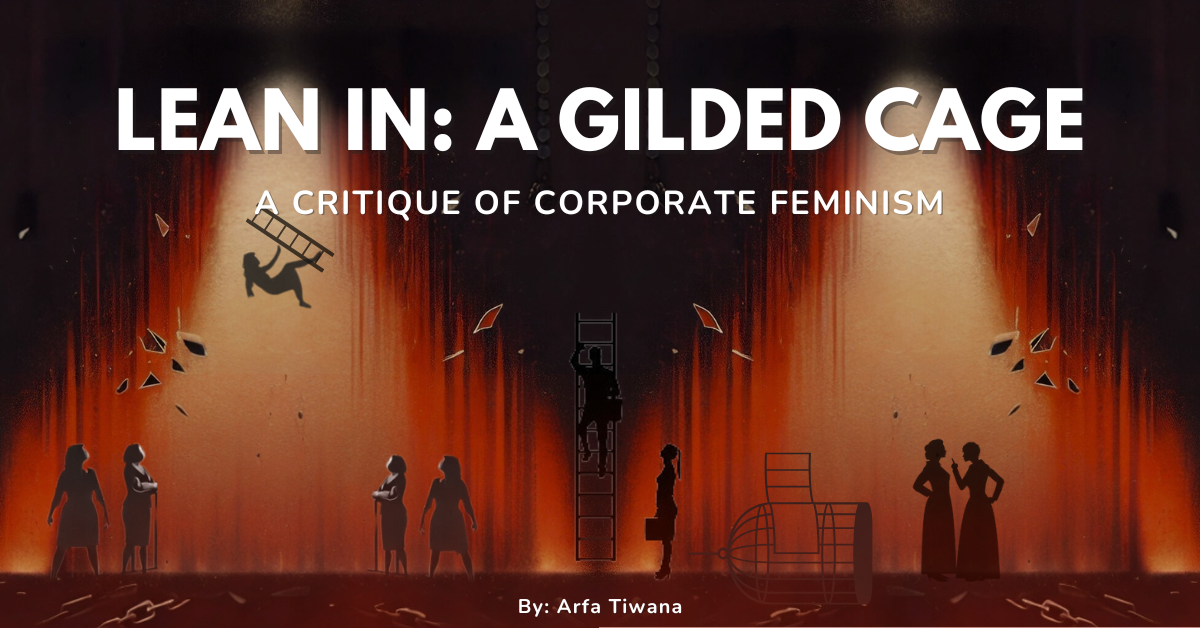As a parliamentary debater, I’ve encountered numerous motions spanning political, economic, legal, and philosophical realms, among others. One motion, in particular, stood out to me: This House believes that the feminist movement should promote the maximization of individual development and empowerment over solidarity among women.
The way I interpret this motion is from the perspective of a book Sheryl Sandberg wrote in 2013 called ‘Lean In: Women, Work and the Will to Lead’. She explores how women must pursue their ambitions more proactively and seek leadership opportunities, regardless of the challenges. For many debaters, this motion was yet another uninspired topic to overcome so their fingers could finally clasp the arms of a trophy. For me, it was a question that lingered in my mind. As a woman, I’m constantly conditioned to believe my purpose in life is to please others, but the capitalistic structures of our society teach me an opposing sense of individualism. This raises the question: is the duty I owe to myself more substantial than the one I owe to my gender?
Sheryl argues that a vast majority of women disparage themselves to believe that they are inferior to men, and this diffident soliloquy often becomes a self-fulfilling prophecy in which women rarely take risks or assert their ambitions. This keeps them from ever being able to self-actualize or meet their utmost potential. Most of us would even agree that we have internalized some degree of misogyny, and often find ourselves reeling in imposter syndrome. Ergo, it becomes imperative for the feminist movement to focus on motivating women towards their individual goals and development.
While this sounds promising, this argument puts an unwarranted onus on women to change their behavior and be ‘more like men’. A woman’s oppression is not her own to rectify, but society’s flaw that it must desecrate itself. It is pertinent to note here that many institutions do not operate purely on meritocracy; they are bigoted and biased. Most women cannot break the glass ceiling or achieve their aims by being more confident or hardworking, insofar as there are actual structural barriers that need to be dismantled. As we advocate for a woman’s individual growth, we overlook the overarching patriarchal structures around us. Society needs to fix itself. We will not take responsibility any longer.
Promoting individual maximization may involve empowering women to participate in structures that can individually benefit them even if these establishments have forever been entrenched in misogyny and sexism. Investing in specific women and micro-goals, such as leadership training and mentorship programs, could potentially mean having women CEO’s and leaders. Indisputably, the corporate structure has been notorious for its hostility towards women, but some argue that this should not keep women from being able to become leaders. To each their own. Women have always been taught to compromise on their values and goals for others—sacrificing their careers for their children, subsiding their social life to make their husbands feel more secure, not wearing certain clothes to defer to their culture and the list goes on endlessly. It then sounds logical for the feminist movement to promote women being able to prioritize themselves, regardless of whether it means hurting another man or even a woman in the process.
The problem with this notion, however, is that it is merely a capitalistic farrago of what feminism was supposed to be. Feminism initially was never about individuality. It was always about sisterhood and looking out for each other. We had the suffrage movement not because a single group of women wanted the right to vote, but because we realized that this was a fundamental liberty that belonged to everyone, including women. The feminist movement is a safe haven for women to find companions who share their suffering, to uplift the most vulnerable in society, and to uproot the same structures that have oppressed us for centuries. Colluding with the oppressor and becoming one with the corporate structurerisks replicating the same oppressive behaviors attributed to men. Corporate culture actively encourages women to emulate male executives. There has been a rise in accusations of unfair labour practices in women-led companies. It is our moral responsibility to boycott institutions that have historically marginalized women, rather than participating in them for our own selfish desires. We do not want a seat at the corporate table. We have a problem with the table itself.
Sandberg attempts to mobilize systemic change by discussing how workplaces should amend themselves to be more female-friendly—that is, have paid leave, better daycare facilities, and stricter harassment laws. This can be done by first placing women at the top and then using the trickle-down effect, correcting the system itself. Having women as leaders not only means that they are liberated from society’s subjection but also that they can serve as role models for other girls in society. Role models are important. They enable you to visualise what success, for you, can look like and makes you believe that your goals are actually attainable.
Critics argue that Sandberg’s ideas quintessentially lionize racist and classist ideals of success. Her advice on individual growth was targeted towards women who had a certain level of privilege; they should have access to higher education, cultural capital, and opportunities in workplaces. On the contrary, women of color, LGBTQ+ women, working-class women, or differently abled women do not have the capacity to ‘lean in’. Intersectionality emphasizes the importance of multiple identities like race, class and sexuality compounding a woman’s experience of discrimination. Lean In is not feminism. It’s a call for privileged women to climb higher on a ladder that was never meant for the rest of us.
Two years have passed since I came across that motion. After two years of contemplation and perusal, I have come to a conclusion about what Lean In feminism truly is. It promises empowerment, but is nothing more than a gilded cage. It disguises its chains as gold, offering liberation while suffocating those who need freedom the most. The goal is not to ascend a ladder that is inherently sexist—we demand that the ladder itself be torn apart. The feminist movement is not a celebration of individual triumphs, but is a collective struggle to rip apart the chains that bound us all to oppression. This is not about breaking the glass ceiling—it’s about ravaging apart the callous systems that confine us.
By Arfa Tiwana
Writer (Team 2024-2025)

